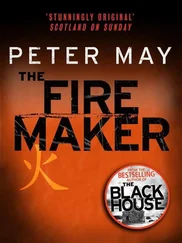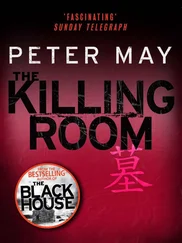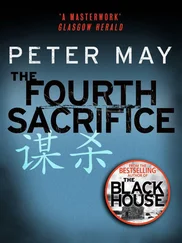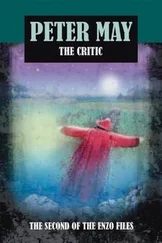Peter May - Chinese Whispers
Здесь есть возможность читать онлайн «Peter May - Chinese Whispers» весь текст электронной книги совершенно бесплатно (целиком полную версию без сокращений). В некоторых случаях можно слушать аудио, скачать через торрент в формате fb2 и присутствует краткое содержание. Год выпуска: 2012, Жанр: Триллер, на английском языке. Описание произведения, (предисловие) а так же отзывы посетителей доступны на портале библиотеки ЛибКат.
- Название:Chinese Whispers
- Автор:
- Жанр:
- Год:2012
- ISBN:нет данных
- Рейтинг книги:4 / 5. Голосов: 1
-
Избранное:Добавить в избранное
- Отзывы:
-
Ваша оценка:
- 80
- 1
- 2
- 3
- 4
- 5
Chinese Whispers: краткое содержание, описание и аннотация
Предлагаем к чтению аннотацию, описание, краткое содержание или предисловие (зависит от того, что написал сам автор книги «Chinese Whispers»). Если вы не нашли необходимую информацию о книге — напишите в комментариях, мы постараемся отыскать её.
Chinese Whispers — читать онлайн бесплатно полную книгу (весь текст) целиком
Ниже представлен текст книги, разбитый по страницам. Система сохранения места последней прочитанной страницы, позволяет с удобством читать онлайн бесплатно книгу «Chinese Whispers», без необходимости каждый раз заново искать на чём Вы остановились. Поставьте закладку, и сможете в любой момент перейти на страницу, на которой закончили чтение.
Интервал:
Закладка:
‘Why would he do that?’ The question came from one of the youngest detectives in the Section. Sang Chunlin was tall and wore dark trousers, black shoes and a black jacket. He, too, had a penchant for American-style shades. His thick black hair, cut short side and back, was long on top and swept back in a quiff. The other detectives called him Elvis.
‘If we knew why he did any of it, Elvis, we might be halfway to nailing him,’ Wu said.
‘Well, whatever motivates him it’s not sexual.’ This from Detective Zhao. ‘He didn’t have sex with any of them, did he? There’s been no trace of semen found at any of the scenes.’
‘We don’t know that in this case,’ Wu said. ‘At least, not until we get the reports back from the autopsy and the lab. But, anyway, who knows how he gets his kicks? He takes bits of them away with him.’
Qian came quietly into the room at the back and slipped into a seat. It was unusual for him to be late. But Li knew there would be a good reason. He nodded a silent acknowledgement to his deputy. Qian was several years older than Li. Steady, reliable, the Section plodder. Li had persuaded his superiors at headquarters that Qian should be given the deputy’s job, so that Li could hand him most of the responsibility for running the Section. Qian would be good at that, he had told them. And it would free Li up to take a more active role in leading investigations. And he had been right. It was a partnership that worked well.
The rest of the detectives were now actively engaged in a debate about motivation, a topic of discussion which, until recently, would have been anathema. Traditional Chinese police work was based on the painfully meticulous collection of evidence, leading to culprit and conviction. Only then would motivation become apparent. Unlike the West, where detectives considered motive the starting point of an investigation. But like everything else in China, this too was changing. And Li had been personally instrumental in altering the working practices of Section One.
While he still believed there was value in large group meetings attended by all the detectives, talking through the evidence, discussing the case in the minutest detail, the time it took was no longer a luxury they could afford. The crime rate was soaring as unemployment grew, and it was impossible to keep track of the floating population of itinerant workers moving from city to city. They had to find ways of dealing with crime more quickly and efficiently. They had embraced technology, installing their own Chinese Automated Fingerprint Identification System, CAFIS, at the forensics headquarters at Pau Jü Hutong. Portable computers the size of a briefcase were available to take out on the job. Fingerprints could be taken at any remote location and sent back by landline or cellphone for computer comparison. They had developed software called AutoCAD which could produce scale 3-D computerised re-creations of crime scenes from photographs and a single measurement. They now had access to a computerised ballistics database for the whole of China. And some of the most sophisticated laboratory analysis equipment available had been installed at the new pathology centre in the north of the city. But it was at the sharp end — the working practices of investigating detectives — that reform was most required, and Li had instituted a system of spreading the workload by delegating only two detectives to each case.
It was working well. But this case was different. He needed more men on the job. Each pairing still had its own workload, but every detective in the Section had now been drafted in to work in some capacity on what was in danger of turning into the worst case of serial murder since the People’s Republic came into being in 1949.
Li looked again at the photographs on the wall. A grotesque catalogue of inhuman behaviour. And he couldn’t help but wonder about motivation. There was something very cold and controlled about all these killings. Pathologist Wang had described the latest attack as frenzied , and yet the killer had taken the time to arrange a piece of intestine beside the body, and carefully laid the remaining entrails across the girl’s shoulder. In the previous case, he had taken the contents of the girl’s purse and arranged them on the ground around her feet. It was bizarre behaviour.
All the victims were prostitutes. They had all been murdered within the same square mile of the city’s Jianguomen district, an area where a large population of foreign embassy staff and five-star tourist hotels attracted a slightly higher class of call girl. All had been strangled, although this was not always the cause of death. All had been killed on a weekend. The first victim, twenty-three-year-old Shen Danhua, had been discovered in a quiet cul-de-sac behind the Friendship Store off Jianguomenwai Avenue. Her face and head were so swollen and distorted from strangulation that identification by relatives had been a problem. She had been stabbed thirty-nine times.
There was a gap of three weeks between the first and second murders. The second was found on a building site behind the China World Trade Center by labourers arriving for the early shift. Li looked at the photographs on the wall. They had pinned up a portrait picture of each of the girls to remind them that these were people, not just victims. It was only too easy to become desensitised, to start seeing corpses as dead meat rather than human beings. The second victim, Wang Jia, had been an exceptionally pretty girl. In the photograph her parents had given them, she was smiling radiantly at the photographer. It was a smile that haunted them all, a reminder of their failure. She had been strangled, and then had her throat slashed twice, left to right, one cut severing both carotid arteries, the windpipe, gullet and spinal cord. Her killer had cut open the abdomen from a centre point beneath the ribs, down the right side and under the pelvis to the left of the stomach, and then stabbed at her private parts with the tip of his knife. The pathologist concluded that the attack had been savage and violent.
Just eight days later, the third murder shook the Section to its core. The victim, Lin Leman, was slightly older, nearly thirty, found in an alleyway behind stalls where Russian traders sold furs in Ritan Road. Like the others, she had been strangled and had her throat dissevered. But for the first time, the murderer had removed trophies. The entire abdomen had been laid open, the intestines severed from their mesenteric attachments and placed by the victim’s shoulder. The uterus, the upper portion of the vagina and the posterior two-thirds of the bladder had been removed entirely, and no trace of them could be found in the vicinity of the crime scene. The only conclusion they could draw was that the killer had taken them away with him.
To compound the bizarre nature of the killing, they had found items from her purse laid on the ground around her feet. A comb, a pack of cigarettes, a lighter, a torn envelope bearing a date stamp from just a few days before. Pathologist Wang had expressed the opinion that these items had not arrived there randomly or by chance. It was his belief that the murderer had gone through her purse and deliberately arranged the items he had found there at the feet of the corpse. But he could not offer up any explanation.
Nor could any of them understand why the killer left the unsmoked end of a Russian cheroot close by each body. Clearly he had smoked the cheroots before committing the murders. To linger for a smoke afterwards would have been to invite discovery. But he must have known that the police would find the butts. And, if he was a man of any education, that DNA could be recovered from traces of saliva. It was like leaving a signature, an artist’s autograph on his work, so that there would be no room for doubt in identifying the author.
Читать дальшеИнтервал:
Закладка:
Похожие книги на «Chinese Whispers»
Представляем Вашему вниманию похожие книги на «Chinese Whispers» списком для выбора. Мы отобрали схожую по названию и смыслу литературу в надежде предоставить читателям больше вариантов отыскать новые, интересные, ещё непрочитанные произведения.
Обсуждение, отзывы о книге «Chinese Whispers» и просто собственные мнения читателей. Оставьте ваши комментарии, напишите, что Вы думаете о произведении, его смысле или главных героях. Укажите что конкретно понравилось, а что нет, и почему Вы так считаете.












